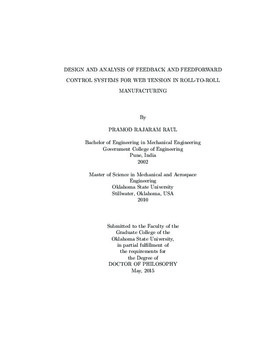| dc.contributor.advisor | Pagilla, Prabhakar R. | |
| dc.contributor.author | Raul, Pramod Rajaram | |
| dc.date.accessioned | 2016-09-29T18:36:39Z | |
| dc.date.available | 2016-09-29T18:36:39Z | |
| dc.date.issued | 2015-05 | |
| dc.identifier.uri | https://hdl.handle.net/11244/45202 | |
| dc.description.abstract | In Roll-to-Roll (R2R) manufacturing, efficient transport of flexible materials (webs) on rollers requires simultaneous control of web speed and tension. Webs experience disturbing forces during transport due to nonideal machine elements and processes such as printing, coating, lamination, etc. Since rotating machine elements are employed, these disturbances are in the form of periodic oscillations in web tension and speed. Design of efficient model-based web tension and speed control systems employing both feedback and feedforward actions that can adapt to changes in parameters and reject periodic disturbances were investigated in this research. Tools from adaptive and robust control theory and singular perturbation method were utilized for the design and analysis of these control systems. | |
| dc.description.abstract | Model reference and relay feedback based adaptive Proportional-Integral (PI) tension control schemes were developed to regulate web tension; these schemes overcome the tedious tuning procedures required for fixed gain PI schemes when process parameters and conditions change. To directly control the roll speed when belt-pulley and gear transmissions are employed, a control scheme that uses both motor and load speed feedback is developed. In the presence of a compliant transmission system, it is shown that using pure load speed feedback must be avoided as it results in an unstable system. In situations where linearization of the nonlinear web tension governing equation is not possible due to changes in operating conditions, a nonlinear tension regulator is designed via a solution method employed in the nonlinear servomechanism problem. The feedforward action is synthesized by considering a discretized form of the tension governing equation in conjunction with adaptive estimation of periodic disturbance parameters. It is also shown that interaction between different subsystems of the R2R system may be minimized by employing feedforward action. The strategy of utilizing tension signal from the web tension zone downstream of the driven roller is shown to result in minimization of propagation of disturbances into further downstream tension zones. For each of the developed designs, experiments were conducted on a large R2R platform for different web materials and transport conditions to evaluate and compare their performance. Implementation guidelines are provided for ease of applying the designs to other industrial R2R machines. | |
| dc.format | application/pdf | |
| dc.language | en_US | |
| dc.rights | Copyright is held by the author who has granted the Oklahoma State University Library the non-exclusive right to share this material in its institutional repository. Contact Digital Library Services at lib-dls@okstate.edu or 405-744-9161 for the permission policy on the use, reproduction or distribution of this material. | |
| dc.title | Design and analysis of feedback and feedforward control systems for web tension in roll-to-roll manufacturing | |
| dc.contributor.committeeMember | Reid, Karl N. | |
| dc.contributor.committeeMember | Chowdhary, Girish | |
| dc.contributor.committeeMember | Rhinehart, R. Russell | |
| osu.filename | Raul_okstate_0664D_14051.pdf | |
| osu.accesstype | Open Access | |
| dc.type.genre | Dissertation | |
| dc.type.material | Text | |
| thesis.degree.discipline | Mechanical and Aerospace Engineering | |
| thesis.degree.grantor | Oklahoma State University | |
